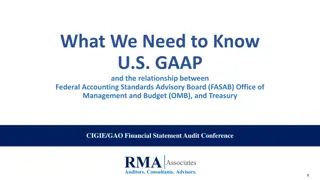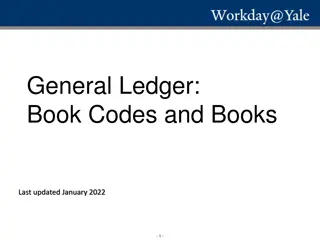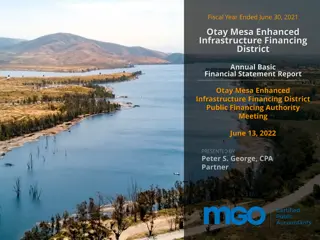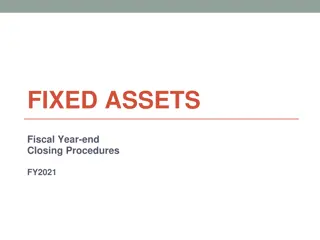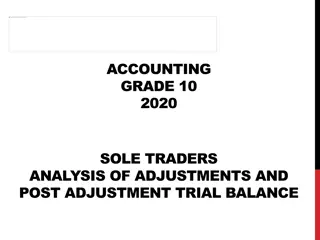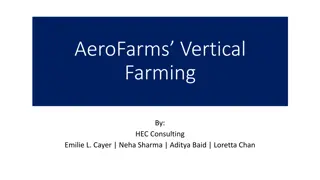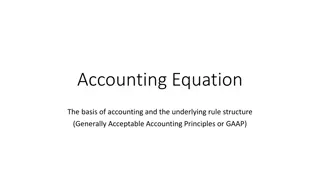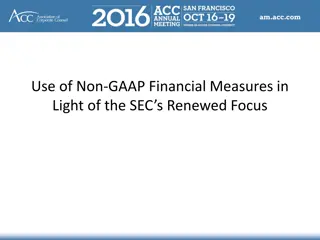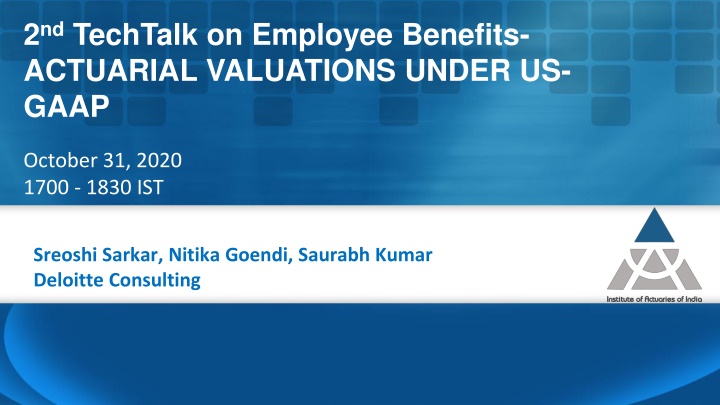
Employee Benefits and Actuarial Valuations Under US GAAP
Explore the landscape of employee benefits with a focus on defined benefit pension plans under US GAAP. Learn about different plan types and post-retirement benefits, including supplemental executive retirement plans and multiemployer plans.
Uploaded on | 0 Views
Download Presentation

Please find below an Image/Link to download the presentation.
The content on the website is provided AS IS for your information and personal use only. It may not be sold, licensed, or shared on other websites without obtaining consent from the author. If you encounter any issues during the download, it is possible that the publisher has removed the file from their server.
You are allowed to download the files provided on this website for personal or commercial use, subject to the condition that they are used lawfully. All files are the property of their respective owners.
The content on the website is provided AS IS for your information and personal use only. It may not be sold, licensed, or shared on other websites without obtaining consent from the author.
E N D
Presentation Transcript
2nd TechTalk on Employee Benefits- ACTUARIAL VALUATIONS UNDER US- GAAP October 31, 2020 1700 - 1830 IST Sreoshi Sarkar, Nitika Goendi, Saurabh Kumar Deloitte Consulting
Polling Question 1 How would you rate your knowledge on pension valuations under US GAAP? 1. US GAAP .sorry, what is that? 2. I have some fundamental knowledge 3. I am at an intermediate level 4. I consider myself an expert www.actuariesindia.org
What to Expect Topic Slide No. Employee Defined Benefit landscape in US 5 Relevant Codifications 7 Basics of Accounting Valuation 9-15 - Pension Expense - Pension Disclosure US GAAP vs IND AS 19/IAS19 17-19 Special Accounting 21-29 Key Assumptions 31-33 Q&A 34 www.actuariesindia.org
Employee Defined Benefit landscape in US www.actuariesindia.org
Employee Defined Benefit Landscape in US Defined Benefit (DB) Pension Plans: A defined benefit plan promises a specified monthly benefit at retirement. The plan may state this promised benefit as an exact dollar amount or, more commonly, it may calculate a benefit through a plan formula that considers such factors as salary and service Defined Benefit Pension: Flat Dollar Plan Set dollar amount for each year you work for the employer Final Average Pay Plan Benefit is calculated using average earnings leading up to retirement Career Average Pay Plan Benefit is calculated based on average earnings during the entire period you were a member of the plan Cash Balance Plan Participants receive a set percentage of their yearly compensation plus interest charges until retirement, which they can convert into an annuity at retirement or take a lump sum Post Retirement Medical and Life Insurance Plans: These are other than pension benefits which retirees receive post employment Supplemental Executive Retirement Plan (SERP): SERP is a set of benefits that is available to top-level employees in addition to those covered in the company's standard retirement savings plan. Multiemployer Plans: A multiemployer plan is a pension plan created through an agreement between two or more employers and a union. The employers are usually in the same or related industries, like construction or transportation. www.actuariesindia.org
Relevant Codifications www.actuariesindia.org
Relevant Codifications ASC 715 Compensation Retirement Benefits 715-10 Overall: ASC 715-10 discusses the overall scope of ASC 715 and the other Subtopics within ASC 715 715-20 Defined Benefit Plans General: ASC 715-20 notes that it provides guidance on the disclosure and other accounting and reporting requirements related to single-employer DB pension and other postretirement benefit plans 715-30 Defined Benefit Plans Defined Benefit Pension: This Subtopic focuses on an employer s accounting for a single-employer DB pension plan. 715-60 Defined Benefit Plans Other Postretirement: A postretirement benefit is part of the compensation paid to an employee for services rendered. 715-70 Defined Contribution plans 715-80 Multiemployer Plans ASC710 - Deferred Compensation Contracts ASC 712 Compensation Nonretirement Postemployment Benefits (Severance or other one- time involuntary termination benefits, long-term disability benefits) ASC 718 Compensation Stock Compensation ASU 2018 14 covers recent changes in disclosure requirements for DB plans under ASC 715-20 www.actuariesindia.org
Basics of Accounting Valuation www.actuariesindia.org
Balance Sheet and Income Statement The Balance Sheet (sometimes referred to as the Statement of Financial Position) reports the Assets, Liabilities and Stockholder s Equity of a company as of a specific date. Balance Sheet Equation: Assets = Liabilities + Stockholder s Equity Funded Status of the plan (Assets PBO) and AOCI (Accumulated Other Comprehensive Income) are Balance Sheet Items The Income Statement (sometimes referred to as the Statement of Profit and Loss) measures a company s financial performance over a specific period of time. The values in the Income Statement will be applied to the Balance Sheet items at the beginning of the period to arrive at the Balance Sheet items at the end of the period. Expense is an Income Statement Item www.actuariesindia.org
What is the Pension Expense? Net Periodic Pension Cost - The annual amount of expense or income an employer must recognize on the income statement to reflect the cost of the pension plan(s) Components of Net Periodic Pension Cost: Service Cost (SC) (1) Interest Cost (IC) (2) Net Periodic Pension Cost (NPPC) Expected Return on Assets (EROA) (3) Amortization of Transition (Asset) / Obligation (4) = (1) + (2) (3) +(4) + (5) +(6) (5) Amortization of Prior Service Cost / (Credit) Amortization of Unrecognized (Gain) / Loss (6) www.actuariesindia.org
Polling Question 2 A frozen DB pension plan (no future accruals) has 10 actives and 100 retiree participants/annuitants in payment. What should be the amortization period for recognition of unrecognized (gain) / Loss? 1. Average Expected Future Service for 10 active participants 2. Average Life Expectancy for 100 retiree participants 3. Average Life Expectancy for all the plan participants 4. None of the above www.actuariesindia.org
Amortizations of Prior Service Cost/(Credit) and (Gain)/Loss Arises when there is a plan amendment that increases or decreases benefits for past service. - The cost is generally spread by amortizing over the expected future service of active participants - If almost all participants are inactive or no active participants, use total life expectancy - Faster amortization methods are not permitted Prior Service Cost/ (Credit) (PSC) Arises because actuarial assumptions are not borne out in practice (asset returns, salary increases, retirements) - Full (gain)/loss is not required to be expensed each year, reduces volatility in expense - At a minimum, amortization in expense of (gain)/loss outside 10% corridor must be expensed - Corridor is equal to: 10% of max (PBO and Market Related Value of Assets) - Amortization period is expected future service of active participants - If the plan is frozen, or almost all participants are inactive or no active participants, use their life expectancy - Faster amortization methods are allowed and must remain consistent over time (Gain) / Loss www.actuariesindia.org
Amortizations of (Gain) / Loss (Contd) Numerical Example: PBO =INR 41,550,000 MVA = INR 45,650,000 Average expected future service for active employees = 9.51 years Actuarial (Gain)/Loss subject to Amortization = INR 12,000,000 Actuarial (Gain)/Loss Subject to Amortization 1 12,000,000 Corridor (10% of Greater of PBO or MVA) 2 4,565,000 Net (Gain)/Loss in Excess of Corridor (1-2) 7,435,000 Amortization Years 3 9.51 Amortization of Net (Gain)/Loss for the Year (1-2)/3 781,809 www.actuariesindia.org
Accumulated Other Comprehensive Income Amounts Recognized in Accumulated Other Comprehensive Income (AOCI) Net (Gain)/Loss = Prior year (gain)/loss recognized during the year + actuarial (gain)/loss + difference between actual and expected return on assets Prior Service Cost / (Credit) = Prior year PSC recognized during the year + new PSC arising during the year Transition (Asset)/Obligation = Prior year T(A)/O - recognized during the year The Total Recognized in AOCI is the sum of Net (Gain) / Loss and Unrecognized amounts www.actuariesindia.org
Disclosure Requirements Specialist s credentials Amounts Recognized in Statement of Financial Position, Funded Status Current/non-current amounts of the benefit asset or liability Amounts Recognized in Accumulated Other Comprehensive Income (AOCI) / Accumulated Unrestricted Net Assets (AUNA) [for non-profit plans] Components of Net Periodic Pension Cost (NPPC) Reconciliation of Benefit Obligation including gains and losses, Reconciliation of Plan Assets Changes in AOCI Plan Assets Allocation Schedule of Expected Contributions & Expected Benefit Payments Summary of Census Data Actuarial Cost Method, Actuarial Assumptions including Rationale for Assumptions Summary of Plan Provisions Interim measurements, plan amendments and special events such as curtailment, settlement, etc. www.actuariesindia.org
US GAAP vs IND AS 19/IAS 19 www.actuariesindia.org
US GAAP and IND AS 19/IAS 19 Key Differences AREA US GAAP IND AS 19 / IAS 19 Funded status on balance sheet, G/L, prior service cost not yet recognized in income are in OCI Balance sheet = funded status Balance Sheet Presentation The guidance permits deferring gains/losses through the use of the corridor approach (or any systematic method that results in faster recognition than the corridor approach). Gains/losses are recognized within statement of P/L as components of NPPC. Gains/losses are recognized immediately in OCI. There is no option to recognize gains/losses in profit or loss (except for other long-term benefits). In addition, the corridor and spreading option which allows delayed recognition of gains and losses is not allowed Expense Recognition - Gain/Loss Expected return is based on an expected rate of return on plan assets. Plan assets are measured at fair value for disclosure purposes. However, for purposes of determining the expected return on plan assets and the related accounting for gains and losses, plan assets can be measured by using either fair value or a calculated value (Market Related Value of Assets) that recognizes changes in fair value over a period of not more than five years. Interest income is calculated by applying the discount rate to the asset of the plan. Measurement is based on the fair value of plan assets. Expense Recognition expected return on plan assets www.actuariesindia.org
US GAAP and IND AS 19/IAS 19 Key Differences AREA US GAAP IND AS 19 / IAS 19 Requires prior service costs to be initially recognized in OCI and then amortized through net income over future periods (expected future service to eligibility or life expectancy, as appropriate) Requires immediate recognition in income for the effects of plan amendments that create an increase (or decrease) to the benefit obligation Expense Recognition Prior Service Costs/Credits Can use Fair Value or Market Related Value of Assets (which recognizes G/L over 5 years) Must use Fair Value, bid price for securities quoted in an active market Plan Assets Multiple attribution models are acceptable Must use projected unit credit Deferred Compensation Arrangements www.actuariesindia.org
US GAAP and IND AS 19/IAS 19 Key Differences AREA US GAAP IND AS 19 / IAS 19 The discount rate is based on the rate at which the benefit obligation could be effectively settled. Companies may look to the rate of return on high- quality, fixed-income investments with appropriate durations (the regulators have weighed in on what constitutes high quality), no guidance where no deep markets exist. Determined by reference to market yields at the end of the reporting period on high quality corporate bonds, or Government bond yield if no deep market (or Govt. bond yields under IND AS19). Discount Rate There is no limitation on the size of the net pension asset that can be recorded on the balance sheet. Asset ceiling (IFRIC 14) based on recoverability of surplus (an asset ceiling is the present value of economic benefits available in the form of an unconditional right to a refund or reductions in future contributions to the plan). Asset Ceiling www.actuariesindia.org
Special Accounting www.actuariesindia.org
Curtailment under US GAAP An event which significantly reduces the expected years of future service of present employees: Plant closing Restructuring (Example: Large layoff) Divestiture Example of an event which eliminates the accrual of defined benefits for future services for a significant number of active participants Hard freeze an amendment to a DB plan that permanently eliminates future benefit accruals. Soft freeze an amendment to a DB plan that eliminate benefits for future service, but takes into account continued salary increases Determining if a Curtailment Occurred under US GAAP An employer should apply judgment in evaluating what is significant. The determination of significance is a matter of judgment; however, in general, a decrease in expected years of future service of 10% or more is considered significant www.actuariesindia.org
Polling Question 3 A Company s DB pension plan has 1,000 active participants. As a part of restructuring, 150 participants were laid off. Will this event trigger a curtailment? 1. Yes 2. No 3. Cannot Say ( Need More Information ) www.actuariesindia.org
Measuring Effects of a Curtailment Under US GAAP If there is a curtailment: A portion of Unrecognized Prior Service Cost (+ Unrecognized Transition Obligation) included in Accumulated Other Comprehensive Income (AOCI) will be recognized The PSC included in AOCI associated with years of service no longer expected to be rendered as the result of a curtailment is a loss for Pension Plans. Recognition of a portion of unrecognized prior service cost is as follows: Determine the proportion of the future years of service that are eliminated Multiply proportion by: Unrecognized Prior Service Cost (UPSC) Unrecognized Transition Obligation (UTO) (if any) This result is recognized Recognized means that there is an impact on the organization s income statement (annual expense). www.actuariesindia.org
Measuring Effects of a Curtailment Under US GAAP The change in PBO might be recognized. The PBO may be decreased (a gain) or increased (a loss) by a curtailment To the extent that such a gain exceeds any unrecognized net loss (or the entire gain, if an unrecognized net gain exists), it is a curtailment gain To the extent that such a loss exceeds any unrecognized net gain (or the entire loss, if an unrecognized net loss exists), it is a curtailment loss Example: Before Curtailment Effect of Curtailment After Curtailment - PBO reduced by 400 - 10% reduction in future service PBO -2,000 400 -1,600 FVA 1,500 0 1,500 Funded Status -500 400 -100 30 Unrecognised PSC 300 -30 270 Unrecognised (G)/L 350 -350 0 (400)-350=(50) Total AOCI 650 -380 270 = (20) A net gain of 20 recognized in expense www.actuariesindia.org
Curtailment - US GAAP and IND AS 19/IAS 19 Differences US GAAP IND AS 19/ IAS 19 Definition A curtailment is defined as an event that significantly reduces the expected years of future service of present employees or eliminates for a significant number of employees the accrual of defined benefits for some or all of their future service. A curtailment occurs when an entity significantly reduces the number of employees covered by a plan. A curtailment may arise from an isolated event, such as the closing of a plant, discontinuance of an operation or termination or suspension of a plan Timing of recognition Curtailment losses are recognized when they become probable and reasonably estimable, which may be before the announcement. Curtailment gains are recognized when employees are terminated or amendments are adopted, which may be after the commitment. Curtailment gains/losses are recognized at the earlier of when the curtailment occurs or when the entity recognizes the related restructuring costs or termination benefits. Measurement Under US GAAP, such gains and losses reflect the increase or decrease in the benefit liability that exceeds the net actuarial gains or losses, in addition to any unrecognized prior service costs no longer expected to be incurred From a measurement perspective, curtailment gains and losses under IAS 19 are based on changes in the benefit obligation, which is recognized in the Expense. www.actuariesindia.org
Settlement Under US GAAP A transaction that meets the following three criteria: 1. Is an irrevocable action. A transaction is irrevocable if it cannot be revoked, recalled or undone; the transaction or event is unalterable 2. Relieves employer (or plan) of primary responsibility for pension benefit obligation 3. Eliminates significant risks related to the benefit obligation and assets used to effect the settlement Examples: Payout of lump sums Purchase of annuities Determining if a Settlement Occurred Under US GAAP Timing of Recognition A settlement will not be recognized until required assets have been transferred and the settlement is fully executed (e.g. lump sum) Settlement accounting is triggered if the settled amounts exceed Service Cost + Interest Cost for the year. www.actuariesindia.org
Measuring Effects of a Settlement Under US GAAP Effect measured as: Change in Projected Benefit Obligation, Change in Plan Assets Recognition of proportionate amount of Unrecognized net (gain) or loss and Unrecognized transition (asset) or obligation if any Percent of PBO settled times [Unrecognized (gain)/loss] = Settlement (Gain) or Loss Example: Before Settlement Effect of Settlement After Settlement PBO -2,000 400 -1,600 FVA 1,500 -400 1,100 Funded Status -500 0 -500 Unrecog PSC 300 0 300 Unrecog (G)/L 500 -100 400 Total AOCI 800 -100 700 Settlement charge recognized in expense = 100 www.actuariesindia.org
Polling Question 4 Gratuity benefits of INR 3 million were paid during the fiscal year in the normal course of business. Will this trigger a settlement under US GAAP? For that fiscal year, Service cost + Interest cost = INR 2 million. 1. Yes 2. No 3. Cannot Say ( Need More Information ) www.actuariesindia.org
Settlement - US GAAP and IND AS 19/IAS 19 Differences US GAAP IND AS 19/ IAS 19 Definition Settlement Trigger Definition: Settlement benefit payments greater than Service Cost plus Interest Cost for the year Only extraordinary payments are generally considered settlements (e.g. lump sum window). If plan offers Lump Sum as a form of payment AND the actuarial assumptions include them, then it s not considered a settlement (even if LS > SC + IC). Measurement Settlement gain or loss is the difference between the present value of the defined benefit obligation being settled and the settlement amount, plus a pro rata portion of previously unrecognized actuarial gains and losses Settlement gain or loss is generally measured as the difference between the present value of the defined benefit obligation being settled and the settlement amount which is recognized in the Expense. www.actuariesindia.org
Key Assumptions www.actuariesindia.org
Key Assumptions Economic assumptions Discount rate Long-term rate of return Salary increase Demographic assumptions Mortality Turnover Retirement Assumptions specific to US Pension Plans Cash Balance Interest Crediting Rate (applicable for cash balance plans only) Lump Sum Conversion (applicable where a plan allows accrued benefit payable as an annuity to be converted into a lump sum) Assumptions specific to US Medical Plans Health Trend Per Capita Claims Costs Expected Increases in Retiree Contributions OPEB Election Percentage Medicare Part D www.actuariesindia.org
Discount rate A discount rate reflects the fiscal year-end economic conditions and the rate at which benefit obligations could be effectively settled The accounting literature expects that the discount rate will reflect: The measurement date Yields available on high-quality fixed income instruments The demographics and benefit provisions of the plan Different approaches taken by the Entity to support discount rates for defined benefit plans: Yield Curve approach Hypothetical Bond Portfolio (HBP) In general, the discount rate is expected to be determined for each plan individually, unless multiple plans have similar characteristics Alternative spot rate approach or Granular approach to measure the Service Cost and Interest Cost component of expense as well as the benefit obligation Example - The Service Cost under this method is determined by multiplying each of the projected benefit payments underlying the Service Cost by the corresponding yield curve spot rates www.actuariesindia.org
Expected Long-Term Rate of Return (LTRR) & Mortality LTRR Should represent the average rate of earnings expected over the long term on the funds invested to provide future benefits (existing plan assets and contributions expected during the current year) If the target allocation of plan assets to different investment categories has changed from the prior year or is expected to change during the coming year, an entity should consider discussing with its actuaries and independent auditors whether an adjustment to its assumption about the long-term rate of return is warranted Mortality Assumptions Under FASB ASC 715-30-35, the mortality assumption is expected to be based on recent tables, and to reflect the employee base covered under the plan to the extent that such plan experience is credible Selection of a mortality assumption generally involves a two-step process: (1) choosing an appropriate set of base mortality tables, and (2) selection of (past and future) mortality improvement rates www.actuariesindia.org
Any questions ? www.actuariesindia.org





